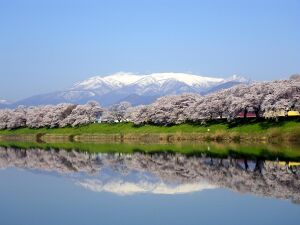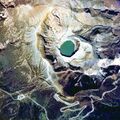Earth:Mount Zaō
| Zaō Mountains | |
|---|---|
| 蔵王連峰 | |
 The Zaō Mountains as seen from the Shiroishi River, an Abukuma River tributary, at the cherry blossom season | |
| Highest point | |
| Elevation | 1,841 m (6,040 ft) [1][2] |
| Listing |
|
| Coordinates | [ ⚑ ] : 38°08′38″N 140°26′24″E / 38.144°N 140.44°E [1] |
| Geography | |
Lua error in Module:Location_map at line 522: Unable to find the specified location map definition: "Module:Location map/data/Japan Tohoku" does not exist.
| |
| Country | Japan |
| Island | Honshu |
| Prefectures | Yamagata and Miyagi |
| Geology | |
| Mountain type | Complex volcano |
| Last eruption | May 1940[1] |
| Lua error in Module:Mapframe at line 384: attempt to perform arithmetic on local 'lat_d' (a nil value). | |
The Zaō Mountains (蔵王連峰 Zaō Renpō), commonly called Mount Zaō, are a complex cluster of stratovolcanoes on the border between Yamagata Prefecture and Miyagi Prefecture in Japan . The central volcano of the group includes several lava domes and a tuff cone, Goshiki-dake, which contains a crater lake named "Okama". Also known as the "Five Color Pond" (五色沼, goshiki numa) because it changes color depending on the weather, it lies in a crater formed by a volcanic eruption in the 1720s. The lake is 360 metres (1,200 ft) in diameter and 60 m (200 ft) deep, and is one of the main tourist attractions in the area.
One striking feature of Zaō's famous ski resorts are the "frost-covered trees" (樹氷, juhyō) that appear in mid-winter. Strong wind over the nearby lake fling water droplets which freeze against the trees and their branches, until near-horizontal icicles begin to form. Falling snow settles on the ice formations, and the end result is a grotesque figure of a tree. The effect of a full forest of such trees gives visitors a ghostly impression. Zaō is one of the 100 Famous Japanese Mountains.
Rotaria rotatoria[3] and Pinnularia spp.[4] are found in the acidic Okama Lake.[5]
See also
- Snow country (Japan)
- Zaō Ropeway
References
- ↑ 1.0 1.1 1.2 "Zaozan [Zaosan"]. Smithsonian Institution. https://volcano.si.edu/volcano.cfm?vn=283190.
- ↑ "Topographic map of Zao". https://opentopomap.org/#marker=14/38.14391/140.43973.
- ↑ Deneke, Rainer (2000). "Review of rotifers and crustaceans in highly acidic environments of pH values ≤ 3". Hydrobiologia 433 (1–3): 167–172. doi:10.1023/a:1004047510602.
- ↑ Negoro, K (1940). "A Pinnularia from Okama, an acidotrophic crater lake of volcano Zao". Jpn. J. Limnol. 9: 176–179. doi:10.3739/rikusui.9.176.
- ↑ Anzai, T (1938). "Limnological observation of Okama, a crater lake of Volcano Zaō". Jpn. J. Limnol. 8 (3–4): 264–272. doi:10.3739/rikusui.8.3-4_264.
External links
- "English Travel information on Mt. Zao". https://www.thehiddenjapan.com/zao.(in English)
- Zaozan - Japan Meteorological Agency (in Japanese)
- "Zaozan: National catalogue of the active volcanoes in Japan". http://www.data.jma.go.jp/svd/vois/data/tokyo/STOCK/souran_eng/volcanoes/033_zaozan.pdf. - Japan Meteorological Agency
- "Zao" (in ja). Geological Survey of Japan. https://gbank.gsj.jp/volcano/Act_Vol/zao/text/exp-1.html.
 |







